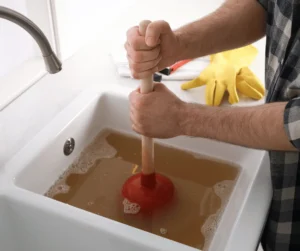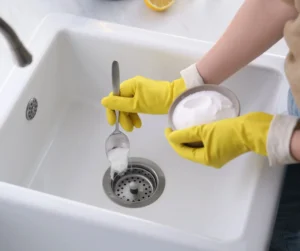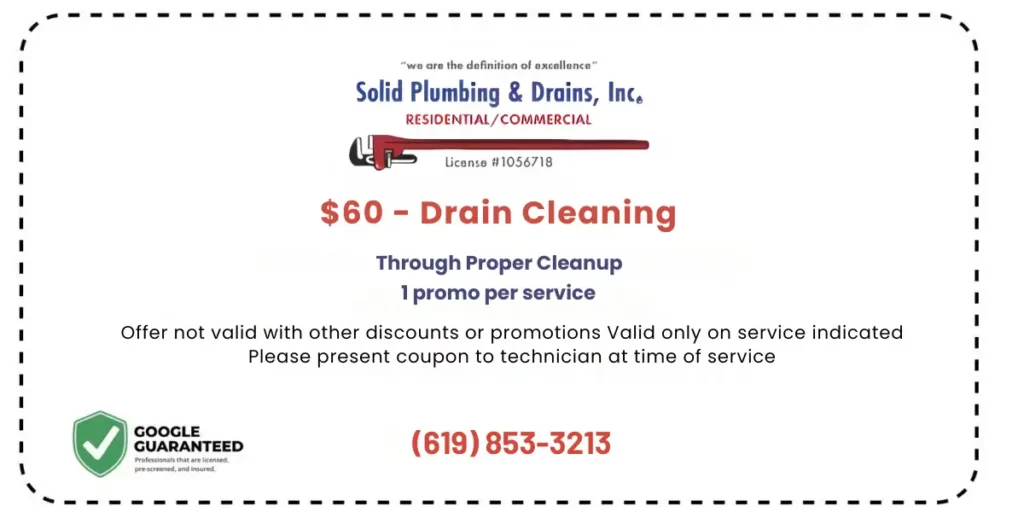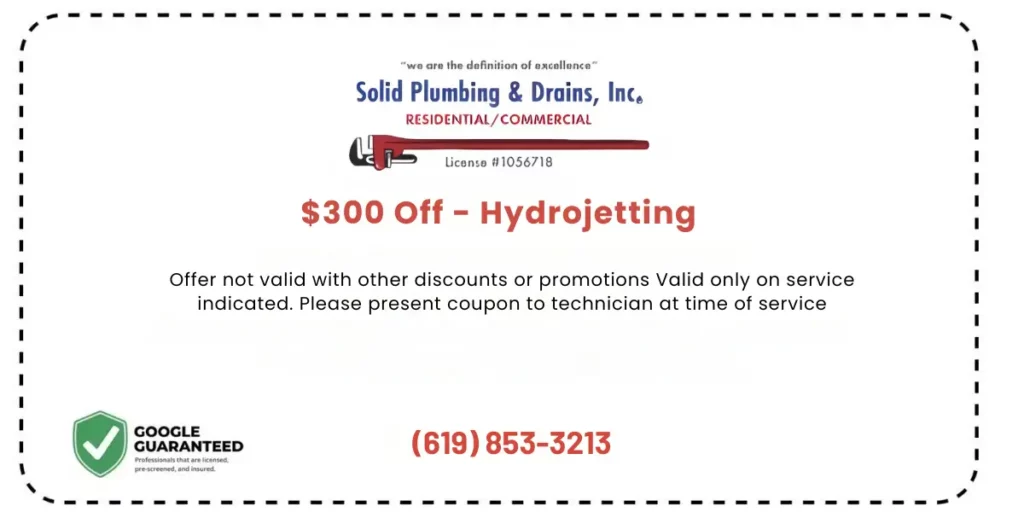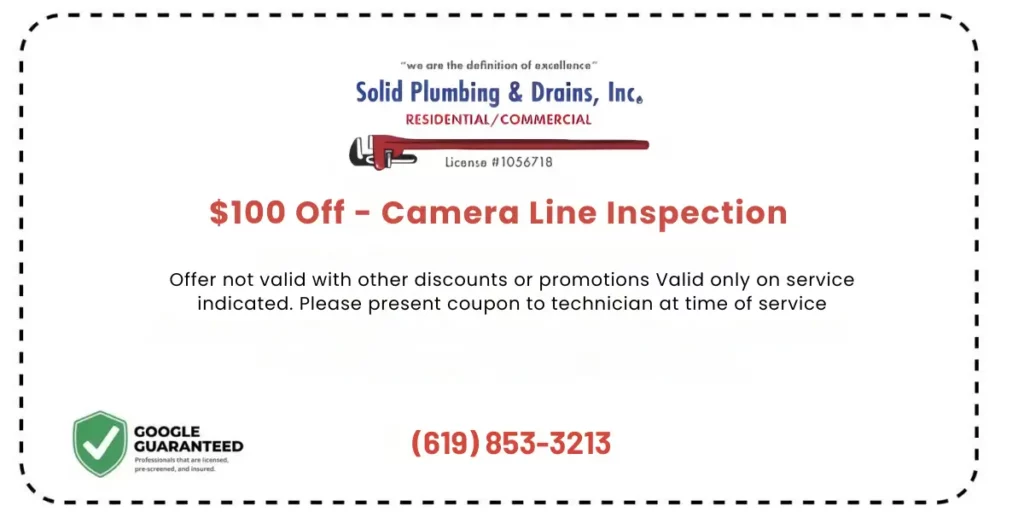When your sink won’t drain or your shower starts backing up, you’re faced with a forest of options promising to solve your problem. From chemical solutions at the grocery store to DIY techniques found online to professional services, the choices can be overwhelming—especially when you need a solution fast.
At Solid Plumbing & Drain Inc., we’ve spent 20 years helping homeowners throughout San Diego County resolve drain issues using various techniques. We’ve tested virtually every method available, giving us unique insight into what actually works for the specific drain challenges faced by Southern California homes.
In this comprehensive, honest review, you’ll discover which drain cleaning methods are effective for different situations, which are wastes of money, and which might actually damage your San Diego home’s plumbing system. We’ll cut through the marketing hype to give you the straight facts based on two decades of hands-on experience.
Understanding San Diego’s Unique Drain Challenges
Before evaluating cleaning methods, it’s important to understand why San Diego homes experience distinctive drain issues compared to properties in other regions.
Hard Water’s Impact on Your Drains
San Diego County has some of the hardest water in the nation, with mineral content often exceeding 250 parts per million. These minerals—primarily calcium and magnesium—accumulate inside pipes over time, creating rough surfaces where debris easily catches and builds up.
This mineral buildup is particularly problematic in older neighborhoods like North Park, Mission Hills, and Kensington, where decades of hard water have created significant interior pipe scaling. Even newer communities in areas like Carmel Valley and 4S Ranch aren’t immune, as our hard water begins creating accumulation from day one.
Unique Local Vegetation and Root Intrusion
San Diego’s distinctive landscape creates specific drain and sewer challenges. Drought-resistant trees and shrubs common in our region—such as eucalyptus, pepper trees, and certain palm varieties—have aggressive root systems that actively seek moisture. These roots are naturally drawn to the tiny leaks and joints in sewer lines, where they can quickly develop into massive blockages.
In established neighborhoods with mature landscaping, such as Point Loma, La Jolla, and Loma Portal, root intrusion represents one of the most common and challenging drain issues we encounter. What begins as a slow kitchen drain can actually indicate roots already penetrating your main sewer line.
Drought-Related Concentration Effects
During Southern California’s frequent drought periods, water conservation measures inadvertently intensify drain problems. When households reduce water usage, less flow moves through the plumbing system, allowing more sediment and debris to settle in pipes rather than being carried away.
The reduced flow from low-flow fixtures, while excellent for conservation, often proves insufficient to carry waste effectively through existing plumbing systems designed for higher water volumes. This creates a perfect environment for blockages to form and grow unnoticed, particularly in water-conscious communities like Scripps Ranch and Rancho Bernardo.
Chemical Drain Cleaners: The Hard Truth
Chemical drain cleaners are perhaps the most common first response to a clogged drain. Let’s examine how they actually perform in San Diego homes.
How They Work (And Why That Matters)
Chemical drain cleaners fall into three main categories:
– Caustic cleaners (containing lye or potassium hydroxide) work by creating a chemical reaction that generates heat to break down clogs, particularly grease.
– Acidic cleaners (containing sulfuric or hydrochloric acid) dissolve organic material like hair and food waste by aggressive chemical reaction.
– Oxidizing cleaners (containing sodium hypochlorite or peroxides) break down organic material through oxidation reactions.
All these chemicals work by essentially burning through the clog, creating heat and gas as byproducts of their reactions.
Effectiveness Rating: 2/10 for Most San Diego Clogs
After thousands of service calls following failed chemical cleaner attempts, our assessment of their effectiveness for San Diego homes is quite low:
– They typically create only a small hole through the blockage rather than removing it entirely, leading to quick recurrence
– They’re largely ineffective against the hard water mineral buildup common in San Diego plumbing
– They cannot address structural issues like tree root intrusions, pipe collapses, or offset joints
– They struggle with hair clogs, often loosening but not removing the blockage
– They’re completely ineffective against solid objects
In our experience, approximately 70% of San Diego homeowners who try chemical cleaners end up calling for professional service within 30 days, indicating the temporary nature of any relief they provide.
Damage Potential: High
The most concerning aspect of chemical cleaners is their potential to damage your plumbing system:
– Repeated heat exposure weakens pipe joints and connections
– Chemical residue continues corroding pipes long after application
– In San Diego’s older homes with cast iron or clay pipes, these chemicals can accelerate deterioration
– Even PVC and ABS plastic pipes can be damaged by the heat generated during chemical reactions
– The interaction between hard water minerals and drain cleaner chemicals can create additional compounds that damage pipes
Our service records show that homes with histories of regular chemical drain cleaner use typically require pipe replacement 5-10 years sooner than those that avoid these products.
Plungers: Simple But Situationally Effective
The humble plunger represents one of the oldest drain cleaning tools, but its effectiveness varies dramatically by situation.
Types of Plungers and Proper Usage
There are two main plunger types, each designed for specific applications:
– Cup plungers (the classic red rubber cup design) work best on flat surfaces like sink drains
– Flange plungers (with an extended rubber flap) are designed specifically for toilets
Proper technique matters significantly: creating a complete seal, ensuring adequate water coverage, and using deliberate, controlled pressure strokes rather than frantic pumping.
Effectiveness Rating: 6/10 for Minor Clogs
For certain types of blockages, plungers can be remarkably effective:
– Excellent for simple toilet clogs caused by toilet paper
– Moderately effective for minor sink blockages near the drain opening
– Good for dislodging small objects that have just entered the drain
– Useful for testing whether a clog is minor or more serious
However, their effectiveness is limited to clogs relatively close to the drain opening and of a nature that can be dislodged by pressure.
Damage Potential: Low When Used Correctly
When used properly, plungers pose minimal risk to your plumbing system:
– No chemical exposure to pipes
– No mechanical intrusion that might scratch pipe interiors
– Low risk of pushing clogs further into the system if used gently
The primary risk comes from excessive force, which can potentially damage connections under sinks or, in very old systems, crack deteriorated pipes. However, this risk is minimal compared to other methods.
Drain Snakes: Versatile But Requiring Skill
Drain snakes (also called augers) represent a mechanical approach to drain cleaning that physically engages with the blockage.
Consumer vs. Professional Equipment
The difference between consumer-grade and professional drain snakes is substantial:
– Consumer models typically extend 15-25 feet with basic fixed heads
– Professional equipment ranges from 25-200+ feet with interchangeable cutting heads
– Consumer units are manually powered; professional units offer machine assistance
– Professional equipment includes camera inspection capabilities to identify clog type and location
– Professional-grade snakes have significantly more torque and clearing ability
This equipment gap explains why DIY snaking often provides disappointing results compared to professional service.
Effectiveness Rating: 4/10 (DIY) or 7/10 (Professional)
The effectiveness of drain snaking varies dramatically between DIY and professional application:
DIY snaking typically suffers from:
– Insufficient reach to access clogs beyond initial pipe sections
– Inability to navigate multiple pipe bends
– Lack of power to cut through tough blockages
– Risk of getting stuck or breaking in the pipe
– No diagnostic capability to identify clog type
Professional snaking offers:
– Appropriate equipment selection based on clog type and location
– Ability to navigate complex pipe configurations
– Specialized heads for different blockage types
– Camera inspection to ensure complete removal
– Experience to apply proper technique without damaging pipes
For San Diego homes with complex plumbing systems, particularly in older neighborhoods, the limitations of DIY snaking become particularly apparent.
Damage Potential: Moderate to High Without Proper Skill
The risk of damage from drain snaking correlates directly with operator experience:
– Inexperienced users can scratch or crack pipes, particularly PVC and ABS plastic
– Excessive force can damage pipe joints or connections
– Improper head selection can cause more harm than good
– Getting a snake stuck may require additional intervention to retrieve
In San Diego’s diverse housing stock, where pipe materials and conditions vary widely, these risks become particularly relevant. Historic homes in Mission Hills or Kensington with original plumbing are especially vulnerable to damage from improper snaking.
Hydro-Jetting: The Professional Gold Standard
Hydro-jetting represents the most advanced approach to drain cleaning, using high-pressure water to scour pipes clean.
How Professional Hydro-Jetting Works
Professional hydro-jetting systems include:
– A high-pressure pump capable of generating 1,500-4,000 PSI
– A water tank or direct connection to a water source
– A flexible hose that feeds into the drain
– Specialized nozzles with various spray patterns for different applications
As the jetting nozzle moves through the pipe, powerful streams of water blast away accumulated debris, grease, mineral buildup, and even tree roots. The water simultaneously flushes all dislodged material through the system.
Effectiveness Rating: 9/10 for Most San Diego Drain Issues
Hydro-jetting excels at addressing the specific challenges faced by San Diego homes:
– Completely removes hard water mineral buildup that plagues San Diego plumbing
– Effectively clears grease accumulation common in kitchen lines
– Removes root intrusions common in established San Diego neighborhoods
– Cleans the entire pipe diameter, not just a pathway through the clog
– Flushes all debris completely out of the system
The comprehensive nature of hydro-jetting makes it particularly valuable for San Diego’s hard water conditions and mature landscaping that creates root intrusion issues.
Damage Potential: Low When Professionally Applied
When performed by experienced professionals, hydro-jetting poses minimal risk:
– No chemical exposure to pipes
– No mechanical contact with pipe walls
– Appropriate pressure selection based on pipe material and condition
– Pre-inspection to identify any pre-existing damage that might contraindicate jetting
– Camera verification of results without additional pipe stress
The primary limitation is that hydro-jetting should not be used on severely deteriorated pipes, which is why professional inspection always precedes this service.
Enzymatic/Bacterial Cleaners: The Eco-Friendly Option
Biological drain treatments use enzymes or bacteria to break down organic material in drains.
How Biological Treatments Work
Unlike harsh chemicals, biological cleaners work through natural processes:
– Enzymes break down specific organic materials (proteins, fats, carbohydrates)
– Bacteria consume organic waste and multiply, continuing the cleaning process
– The process is gradual rather than immediate
– Regular application builds a beneficial biofilm that prevents buildup
– No heat or chemical reactions occur within the pipes
These products work with nature rather than against it, using biological processes similar to those in wastewater treatment.
Effectiveness Rating: 3/10 for Clogs, 7/10 for Maintenance
Biological cleaners have a split personality in terms of effectiveness:
For existing clogs:
– Too slow-acting for immediate relief
– Often ineffective against complete blockages
– Cannot address mineral buildup, roots, or solid objects
– Require multiple treatments for significant clogs
– May be neutralized by previously used chemical cleaners
For preventative maintenance:
– Excellent for maintaining clear kitchen drains when used regularly
– Good for preventing organic buildup in bathroom drains
– Helpful in reducing odors from organic material
– Environmentally friendly for San Diego’s sensitive ecosystem
– Safe for all pipe materials
This makes biological cleaners better suited for preventative maintenance than emergency clog removal.
Damage Potential: Very Low
Biological cleaners pose minimal risk to your plumbing system:
– No corrosive chemicals
– No heat generation
– No pressure on pipes or joints
– Safe for all pipe materials including older cast iron and clay
– Environmentally friendly for San Diego’s watershed
This safety profile makes them appropriate even for San Diego’s oldest homes with fragile original plumbing systems.
Home Remedy Methods: Separating Fact from Fiction
The internet abounds with DIY drain cleaning methods. Let’s evaluate the most common approaches.
Baking Soda and Vinegar: The Bubble Myth
This popular home remedy involves pouring baking soda down the drain followed by vinegar to create a bubbling reaction.
Effectiveness Rating: 2/10
– The bubbling action is too gentle to dislodge significant clogs
– The reaction occurs primarily at the top of the clog rather than throughout
– Any benefit comes mainly from the hot water flush typically recommended afterward
– May help with minor grease softening but ineffective for most San Diego drain issues
– Completely ineffective against mineral buildup, roots, or solid objects
Damage Potential: Very Low
– No risk to any pipe materials
– No pressure or mechanical stress
– No harmful chemical residue
While largely ineffective, this method at least poses no risk to your plumbing system.
Boiling Water: Simple But Limited
Simply pouring boiling water down a drain is another common recommendation.
Effectiveness Rating: 3/10
– Can help dissolve fresh grease clogs in kitchen sinks
– May dislodge minor soap scum in bathroom drains
– Completely ineffective against hair, mineral buildup, or solid objects
– Does nothing to address clogs beyond the first few inches of pipe
– Temporary relief at best for most clogs
Damage Potential: Moderate
– Safe for metal pipes but can damage or weaken PVC pipe joints
– May cause warping at rubber gaskets and seals
– Can crack porcelain if poured directly into fixtures
– Potential for scalding injuries during application
This method’s limited effectiveness rarely justifies even its modest risks.
Wire Hangers and DIY Tools
Straightened wire hangers and similar improvised tools are often suggested for mechanical clog removal.
Effectiveness Rating: 2/10
– Limited reach (typically 1-2 feet at most)
– Cannot navigate pipe bends effectively
– May push clogs deeper rather than removing them
– Can only hook material rather than cutting through it
– Completely ineffective against mineral buildup or roots
Damage Potential: Moderate to High
While inexpensive and easily available, DIY tools like wire hangers often cause more harm than good:
- They scratch the inside of pipes, especially plastic ones
- Sharp edges can puncture rubber gaskets or flexible joints
- They may become stuck in the pipe, requiring professional extraction
- In older San Diego homes with aging plumbing, even a small scratch can worsen corrosion or leaks
Overall, these improvised methods are rarely effective and frequently end up costing homeowners more in repairs than they save.
What Really Works for San Diego Drains?
After two decades of hands-on experience in San Diego homes, our honest review is simple:
- Best for clogs: Professional hydro-jetting and snaking, especially when used together with camera inspections
- Best for maintenance: Biological enzyme treatments and occasional hot water flushes
- Worst for your pipes: Chemical drain cleaners and DIY metal tools
- Not harmful but not helpful: Baking soda and vinegar, boiling water
In a region where hard water, drought-driven usage habits, and aggressive tree roots all take a toll on plumbing systems, the safest and most effective approach is working with professionals who understand local conditions.
Got a stubborn clog or recurring drain problem? Trust Solid Plumbing & Drains Inc. to diagnose it right and fix it fast.


